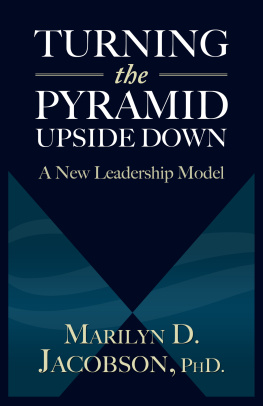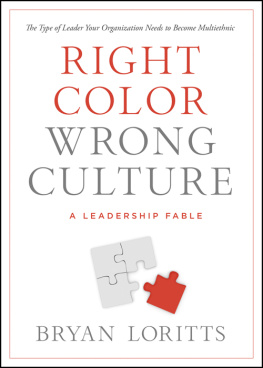Introduction
As a professor of management for seventeen years and a consultant to scores of major businesses, I have witnessed a fundamental change in effective leadership practices.
For generations, the historic and prevailing certainty that organizations are pyramids, with the leadership at the top and workers at the bottom, no longer applies. What we have learned from todays most forward-looking companies is that only by turning the pyramid upside down can an organization in a global marketplace gain and secure competitive advantage. The lesson is that organizations must change significantly if they are to have a future in this rapidly changing world.
In the old paradigm, aspiring leaders were taught that the way to the top was to wring the most out of each of their employees. For a new reality in a new century, a different kind of leadership is required. Leaders must partner and collaborate with their employees to respond to escalating complexities and inspire new thinking and discovery of fresh ideas. The continuous pressure for innovation and new technologies means involving others at all levels within the organization. Employees cannot simply be instruments to achieve leaders goals; they must be allowed and even encouraged to participate in the decision-making and be fully engaged in achievement of organizational goals.
Talent, skills, and leadership capability exist throughout the organizations and emerge when there is need and support. Since decision-making increasingly depends on multiple points of view and candid dialogue, the more perspectives the better. Therefore, restricting leadership to the top and rank and file to the bottom has lost currency; the reality is frontline employees collectively know more of what is crucial to wise policy making.
Globalization influences leadership in the U.S. in a number of ways in respect to buying or selling goods and mergers, acquisitions, and investments. Mastering more than one language and learning how cultures differ in significant ways so that meaningful relationships can be made happens only with effort, research, and sensitivity. The decision is to either train people internally or hire those from the outside who are skilled in these multiple areas.
Arab Spring and the worldwide clamor for voice in leadership affairs are mirrored in American workers increasing dissatisfaction. Worldwide connectivity has brought attention to these uprisings, especially in terms of taking action to deal with what is perceived as despotic leadership. The response seen abroad is reflected in a widespread lack of trust within the U.S. workforce. Employees seek to have a voice. Managers are experiencing burnout and disillusionment. Morale is low. Because most corporations are hierarchical, many employees feel they are marginalized from what is most essential and, not incidentally, most interesting in the business. The irony is that while executives want thought leaders, they do not involve their employees, ask for their input, and most egregiously, do not share information. How can employees be expected to have a reliable thought or point of view? If they are not encouraged to think and are not invited into the dialogue, how can they contribute to discussion or decision-making?
The fundamental issue that leaders face in this global, high-tech environment is how to handle the complexities of strategic planning, decision-making, identifying and developing talent, building relationships and alliances, branding, pricing, marketing, and timing. Obviously, a single leader cannot undertake all this. Even the military that once served as the model for unilateral hierarchical leadership has changed. Partnering and collaboration are replacing command and control hierarchies. Cultures that promote thinking and empowerment provide incentives to contribute on a higher level. Breaking down the hierarchy and internal silos and creating an atmosphere that encourages engagement and attention to employee welfare are the prerequisites to meeting, welcoming, and thriving on change.
My experience consulting with leaders from a broad spectrum of industries informs the thesis of this book. Their stories reflect the need to partner and collaborate, develop new thinking, invite employees into the planning and decision-making process, encourage creative thought, and promote initiative.
They are a distinguished group. Because my consulting engagements extend for years and span a variety of fields (healthcare, retail, financial, manufacturing, service, legal, and government organizations), I have witnessed how leaders made decisions, what they learned, and what others may learn from them. Each story launches commentary based on the authors experience and research.
While these leaders experiences and accomplishments take us to the frontier of a new era, their organizations are still basically top-down. The next bold step is to move away from command-and-control organization structures and toward flatter, inverted pyramid-type organizations. The future role of tomorrows leaders will be quite different from the ones of yesterday. Instead of directing, leaders must develop, support, assist, and foster.
As a result, organizations will change significantly. Only if organizations redesign the structure and the culture to facilitate communication and productive interaction, at a level rarely seen outside of Silicon Valley, can the race to the future be won.
Leadership
The idea of turning the pyramid upside down may seem a bit radical because to be competitive in the new global economy, the magnitude of leadership change necessary defies any possibility that it be incremental. Escalating complexity due to such factors as technology and globalization, along with the continuing need to make the numbers while becoming ever more innovative, requires a kind of organization capable of extraordinarily high levels of purpose, commitment, and synchronicity.
It has been said that organizations are overmanaged and underled. Disappointment with leadership, as we have known it for many generations, has taken different forms. The current malaise in many organizations is a result of either too little leadership or the kind of leadership that has been modeled and passed along for generations, but is proving now to be grossly ineffective. That current breakdown is evident when executives lament the lack of thought leaders and workers lament their lack of autonomy and empowerment. This impasse has come about because leaders do not provide the kind of information and inclusion in decision-making that would produce thought leaders or in any way ensure an engaged workforce.
This is not a new phenomenon. When I was teaching MBA students, I would ask a class regarding the topic of motivation, How would you like to be lead? The most overwhelming responses were more autonomy, empowerment, support, access to viable resources, opportunities to collaborate on projects, and the ability to fully use their skills. When I turned the question around and asked (since many students had others reporting to them), How do you lead? The answers were provide direction, tell when things go wrong, correct mistakes, and follow up to ensure deadlines are met. It was sadly acknowledged that they were perpetuating the style of leadership they disliked. It is this style that needs an immediate overhaul.










